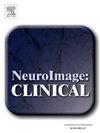不同早产阶段早产儿认知困难的不同神经机制
IF 3.6
2区 医学
Q2 NEUROIMAGING
引用次数: 0
摘要
目的研究9-10岁极早产、中度早产和足月儿童的低认知表现与区域和网络水平的大脑变化之间的关系,并探讨这些变化是否能预测12岁时的ASD/ADHD症状。方法本纵向人群研究包括来自ABCD研究的9 - 10岁美国儿童。使用NIH工具箱对儿童进行脑成像和认知评估。将认知表现低的早产儿(NIH综合评分<; -1SD和>; -2SD)的皮质厚度和皮质下体积与表现典型的早产儿和足月儿童(≥-1SD)的皮质厚度和皮质下体积进行比较。结构协方差网络也进行了检验。结果7281例患儿(平均年龄9.9±0.6岁,男孩占52.2%),重度早产71例,中度早产151例,足月7056例。认知能力低下在极早产儿中最为普遍(29.6%),其次是中度早产儿(24.0%)和足月儿童(16.2%)。认知能力低下的极早产儿与表现正常的极早产儿相比,下颞叶皮层更薄(β = -0.58; p = 0.03),梭状回更薄(β = -0.62; p = 0.02),杏仁核体积更大(β = 0.41; p = 0.05)。认知能力低下的中度早产儿海马体积较小(β = -0.32; p = 0.01)。在比较认知能力低下的早产儿和表现正常的足月儿童时,也观察到类似的模式。结构协方差网络分析显示,认知能力低下的中度早产儿童楔前脑-后脑回对之间存在较强的协方差。从这对中提取的个体化差异结构协方差网络值与ASD/ADHD症状呈正相关,但无统计学意义。结论早产儿认知能力低下与脑区域和脑网络水平的差异有关,且因早产而异。较强的中心协方差可能反映了补偿机制,强调了针对早产儿的干预措施的必要性。本文章由计算机程序翻译,如有差异,请以英文原文为准。

Distinct neural mechanisms underlying cognitive difficulties in preterm children born at different stages of prematurity
Objectives
To examine associations between low cognitive-performance and regional-and network-level brain changes at ages 9–10 in very-preterm, moderately-preterm, and full-term children, and explore whether these alterations predict ASD/ADHD symptoms at age 12.
Methods
This longitudinal population-based study included 9–10-year-old U.S. children from ABCD Study. Children underwent brain imaging and cognitive assessment using NIH Toolbox. Cortical thickness and subcortical volumes of preterm-children with low cognitive-performance (NIH composite score < -1SD and > -2SD) were compared with preterm and full-term peers with typical performance (≥-1SD). Structural covariance networks were also examined.
Results
Among 7281 children (mean age 9.9 ± 0.6 years; 52.2 % boys), 71 were very-preterm, 151 moderately-preterm, and 7056 full-term. Low cognitive-performance was most prevalent in very-preterm children (29.6 %), followed by moderately-preterm (24.0 %) and full-term children (16.2 %).
Very-preterm children with low cognitive-performance had thinner inferior temporal cortex (β = -0.58; p = 0.03), thinner fusiform gyrus (β = -0.62; p = 0.02), and larger amygdala volumes (β = 0.41; p = 0.05) compared to very-preterm children with typical performance. Moderately-preterm children with low cognitive-performance had smaller hippocampal volumes (β = -0.32; p = 0.01). Similar patterns were observed when comparing preterm children with low cognitive-performance to full-term peers with typical performance. Structural covariance network analysis revealed stronger covariance between the precuneus-postcentral gyrus pair among moderately-preterm children with low cognitive-performance. Individualized Differential Structural Covariance Network values extracted from this pair were positively associated with ASD/ADHD symptoms, though not statistically significance.
Conclusion
Low cognitive performance in preterm children is associated with distinct regional and network-level brain differences, differing by prematurity. Stronger hub covariance may reflect compensatory mechanisms, highlighting the need for prematurity-tailored interventions.
求助全文
通过发布文献求助,成功后即可免费获取论文全文。
去求助
来源期刊

Neuroimage-Clinical
NEUROIMAGING-
CiteScore
7.50
自引率
4.80%
发文量
368
审稿时长
52 days
期刊介绍:
NeuroImage: Clinical, a journal of diseases, disorders and syndromes involving the Nervous System, provides a vehicle for communicating important advances in the study of abnormal structure-function relationships of the human nervous system based on imaging.
The focus of NeuroImage: Clinical is on defining changes to the brain associated with primary neurologic and psychiatric diseases and disorders of the nervous system as well as behavioral syndromes and developmental conditions. The main criterion for judging papers is the extent of scientific advancement in the understanding of the pathophysiologic mechanisms of diseases and disorders, in identification of functional models that link clinical signs and symptoms with brain function and in the creation of image based tools applicable to a broad range of clinical needs including diagnosis, monitoring and tracking of illness, predicting therapeutic response and development of new treatments. Papers dealing with structure and function in animal models will also be considered if they reveal mechanisms that can be readily translated to human conditions.
 求助内容:
求助内容: 应助结果提醒方式:
应助结果提醒方式:


